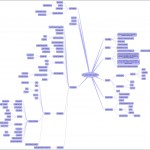Using technology without a sense of purpose/direction leads to wasted resources and could even derail organizations from their missions. I came across a concept called Big M (Marketing) and little m (marketing) in a book (Marketing Management) for my marketing class. The idea is that in marketing, where the customer is at the core of the business, two elements must be considered – strategic (Big M) and tactical (little m). According to the book, strategic marketing is “a long-term, firm-level commitment to investing in marketing – supported at the highest organizational level – to enhance organizational performance.” The tactical element (little m) “serves the firm and its stakeholders at a functional or operational level.” As the book notes, since the customers are at the core of the organization’s business, all parts of the organization must play in the marketing efforts.
I see parallels between marketing and technology as they are used in organizations. Big T (strategic) and little t (tactical) must be considered for technology to provide value to the organization. Without a strategy, an organization may just be chasing “shiny objects” and/or using technology in less optimal ways. It may even be used counterproductive to the mission of the organization. Likewise, without execution, the best technology road map will be just a piece of document.
In education, one topic that surely illicit strong responses from different groups are using technology for educational purposes. One notable example of such a project that may have been caused by a lack or unclear vision is the Los Angeles Unified School District’s attempt to integrate the iPad as a tool in the classroom which somehow ended up in a fiasco. As this article would suggest on why LAUSD canceled the “pads-in-the-classroom” program, it’s not because of the technology, but rather, it’s because of lack of vision.
Another topic of discussion about educational technology revolves around the perceived lack of curriculum design and pedagogy when technology is introduced in the classroom. I believe technology can be beneficial or a distraction to the learning process. When technology is used in the classroom, the question must be asked is how does technology add value to the learning process?
Regarding student affairs, information and communication technologies play an integral role in how student services and enrollment services units conduct their business functions and communicate with students. With students at the core, the different functional units must work as integrated units instead of silos to effectively serve the students and their needs. The information and communication systems used in these units also cannot exist in silos, and neither should there be duplicates, as this could only lead to wasteful spending of tuition and tax money. Furthermore, these siloed/duplicated systems could also lead to inaccurate information and prevent student affairs staff from viewing a holistic view of the students they serve. From the student’s perspective, the lack of unified systems could lead to frustrations and hindrances to their success.
As I noted in this article about Chief Student Affairs Officers as Information Technology Managers, technology requires folks at different levels of the organization to be involved in the strategic and tactical levels. Technology use in student affairs (or any organization) is more than software/hardware as organizational and personal dynamics are involved. For technology to add value to the work done in student affairs, student affairs organizations must ask about the role of technology in student development and learning and, in addition, what would be needed to implement technology for this purpose.
In your organization, is the purpose of technology clear? What are the driving forces behind their uses? Is your organization providing resources/training so technology can be used to its fullest?

